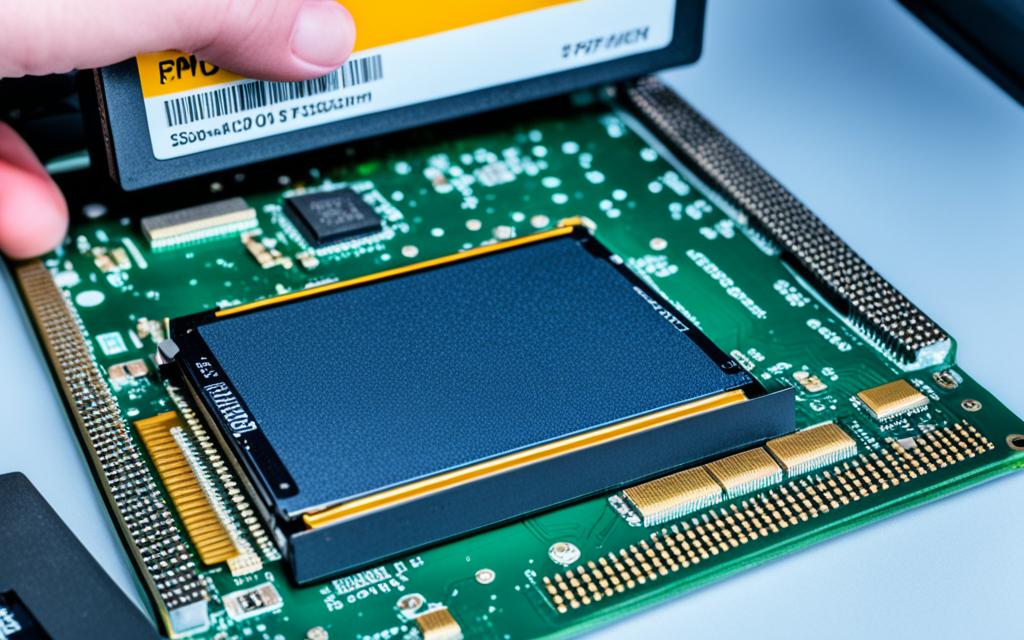Table of Contents
In our fast-paced world, solid-state drives (SSDs) have become key to computing. However, even with their speed and affordability, SSDs are inherently fragile and can fail. It’s critical to check the health of your SSD regularly. This can help catch problems early, keeping your data safe and your drive working well. This article will cover how to effectively test an SSD for failure. We’ll look at various SSD diagnostics tools. Testing usually takes between 2 to 5 minutes, making it a swift way to ensure your SSD is in good shape1.
Key Takeaways
- Understanding SSDs is crucial due to their fragility and the increasing reliance on them in computing.
- Regular SSD health checks can prevent major data losses by identifying errors early.
- Using third-party tools often provides more detailed insights compared to built-in diagnostics.
- SSD testing for failure typically takes just a few minutes, making it easy to incorporate into regular maintenance.
- Awareness of SSD life span and regular monitoring can significantly enhance data security.
Understanding SSDs and Their Fragility
The world of digital storage is always evolving. This is mostly because more people are starting to use solid-state drives (SSDs). Businesses are moving from old hard disk drives (HDDs) to SSDs. They do this for better speed and reliability. But SSDs can also be fragile. They have issues that can make them fail in various ways.
The Rise of SSDs in Modern Computing
SSDs are becoming very popular with tech lovers and businesses. This is because they use NAND flash memory, which is fast and tough. SSDs are much faster than HDDs. They don’t have moving parts. This means they perform better and last longer. There are different SSDs made for different needs. This shows how versatile they are in today’s tech world. One key feature is their Mean Time Between Failures (MTBF) of about 1.5 million hours. People like that SSDs don’t break easily and can handle bumps and shocks well2.
Common Signs of SSD Failure
Even though SSDs have a lot of good points, they can still have problems. It’s important to teach users how to spot when an SSD is failing. Signs to look out for include slow performance, your computer freezing or crashing a lot, and errors in applications3. You might also see files disappearing, find bad sectors, or notice your SSD getting too hot. Other clues are SMART errors or trouble starting up your computer. Too many read/write errors are a red flag too3.
Problems with the SSD’s hardware or logic can make it wear out faster. Especially if it’s used more than its designed write or erase limit. This limit can be anywhere from 500 to 100,000 cycles2.
Methods for Testing an SSD for Failure
It’s vital to know how to test an SSD to keep it running well. Regular checks spot problems before they turn big. You can use Windows SSD tools in your system for basic checks and speed tests.
The Importance of Regular Health Checks
Doing health checks on your SSD is key for a great computer use. SSDs last longer than old hard drives because of smart technology. But they still get worn out with use. Checking them often helps catch issues like bad blocks or errors early, especially after wrong shutdowns4.
Utilising Windows Built-in Tools
Windows has handy SSD tools for drive checks. You can use CHKDSK to find and fix disk errors. For checking SSD features, go to Device Manager. These Windows SSD tools are easy to use, perfect for starting out.
Third-Party Software Solutions
Some prefer outside software for deeper SSD tests. Tools like CrystalDiskInfo and EaseUS Partition Master offer detailed checks. They make it easier to understand your SSD’s status. Users can pick what suits their skills best. Community tips often point out top tools, like SanDisk’s SSD dashboard for testing5.
| Tool | Functionality | User Experience Level |
|---|---|---|
| CHKDSK | Disk error checking and repair | Beginner |
| CrystalDiskInfo | Comprehensive SSD health monitoring | Intermediate |
| EaseUS Partition Master | Partition management and analysis | Advanced |
| SanDisk SSD Dashboard | Simplified performance monitoring | Beginner |
How to Test SSD for Failure: Key Techniques
It’s really important to check your SSD’s health to keep your data safe. There are several good ways to test SSDs. You can use SSD SMART technology, tools like CHKDSK SSD, and programs made by the SSD’s manufacturer.
Using SMART Technology for Health Monitoring
SSD SMART technology is key for checking how well solid-state drives are working. It looks at different things to help users spot problems early on. You can see SMART reports through your computer’s system or other disk tools. These reports give you a good idea of how your drive is doing. If you get a SMART warning, it’s time to check your SSD more closely but it doesn’t always mean it’s about to fail6.
Running Disk Checks via CHKDSK
The CHKDSK tool in Windows is great for looking at your SSD’s health. It checks for errors and tries to fix them. You can start a CHKDSK scan with a simple command, helping you keep your SSD in good shape. Running this tool now and then helps stop small issues from getting worse.
Leveraging Manufacturer-Specific Utilities
SSD manufacturers often have their own tools for checking the drives. Samsung Magician and Intel SSD Toolbox, for example, give detailed checks and updates to keep your SSD running well. It’s really important to keep your SSD’s software up to date for it to work reliably7. These tools also tell you how much you’ve used your SSD and its condition, helping you decide about your storage needs.
Tools for Comprehensive SSD Testing
In our digital world, keeping your SSD in top shape is key for the best performance. There are many SSD health check tools to help you watch over, manage, and boost your drive’s performance. Each tool has special features that give a deep look into how well your SSD is working.
Overview of Popular SSD Health Check Tools
Some of the top tools include EaseUS Partition Master, CrystalDiskInfo Aoi Edition, and MiniTool Partition Wizard. These tools offer things like health checks, making your SSD run better, and testing how fast it can work. For example, MiniTool Partition Wizard allows users to check their SSD’s health and learn about their read and write speeds.
Comparing Diagnostic Software Features
When looking at comparing SSD diagnostic software, think about the ease of use, how quickly it can give reports, and how much detail it offers. Below is a list highlighting the main features of some well-known SSD health tools:
| Tool Name | Health Assessment | Performance Optimisation | Benchmarking Capability |
|---|---|---|---|
| EaseUS Partition Master | Yes | Yes | Comprehensive |
| CrystalDiskInfo Aoi Edition | Yes | No | Basic |
| MiniTool Partition Wizard | Yes | Yes | Advanced |
Such tools are crucial for keeping your SSD working flawlessly, showing it’s reliable and efficient. By keeping an eye on your SSD and using the right tools, you can cut down the risk of losing data. This helps make sure your SSD performs well89.
Conclusion
It’s crucial to test your SSD regularly for any signs of failure. This step is key to making your storage device last longer. As we use SSDs more, knowing how to check them for problems is vital to prevent losing data. SSDs might show fewer warning signs, but we still need to keep an eye on them. There isn’t a sure way to tell when they might fail10. By doing regular checks with different tools, you can keep your data safe and make your system work better.
The SSD Endurance Experiment shows that not all SSDs are the same in how long they last11. Some brands, like Corsair and Samsung, could handle more, while others broke down quicker under the same conditions. This tells us we must keep checking our SSD’s health. Failures could happen sooner than we think, depending on how we use them. Making these checks part of your regular routine can help avoid major data loss.
In short, knowing the limits of your SSD and using good testing practices can help it last longer and work better. Realising the importance of SSD tests makes it a key part of caring for our computers. Make these steps part of your tech habits to ensure a bright future for your SSD.
FAQ
What are the most common signs of SSD failure?
If your SSD is failing, it might get slower, crash apps unexpectedly, and show frequent Blue Screen of Death errors. It could also become read-only. Knowing these signs helps protect your data and act fast.
How can I perform health checks on my SSD?
To check your SSD’s health, use Windows tools like CHKDSK and the SSD properties. Programs from others, like EaseUS Partition Master and CrystalDiskInfo, are easy to use for deeper checks.
What is SMART technology, and how does it help?
SMART stands for Self-Monitoring, Analysis, and Reporting Technology. It’s in SSDs to report important data, to assess health. It watches over your SSD, spotting problems early to prevent failure.
Are there specific tools for diagnosing SSD health?
Certain tools like EaseUS Partition Master, CrystalDiskInfo, and MiniTool Partition Wizard are made for checking SSD health. They do health checks, improve performance, and benchmark, for different needs.
How often should I test my SSD for potential failure?
Checking your SSD every few months is a good idea to catch potential failures early. Regular checks ensure it works well and lasts long.
What advantages does third-party software offer for SSD diagnostics?
Third-party programs can dig deeper than standard tools, giving detailed analyses and extra features. They improve your SSD’s performance and run brand-specific diagnostics.
What should I do if I suspect my SSD is failing?
If you think your SSD might fail, first back up your data to avoid loss. Then, use SMART and CHKDSK to find any errors. If problems don’t stop, get help from a professional.
Why is it important to understand SSD fragility?
Knowing why SSDs can fail matters because, while fast and reliable, they can stop working suddenly. Understanding the risks lets you guard your data and keep everything running smoothly.
Source Links
- https://www.easeus.com/partition-master/check-ssd-for-errors.html – 3 Efficient Ways to Check SSD for Errors on Windows 10/11
- https://www.backblaze.com/blog/how-reliable-are-ssds/ – Are Solid State Drives / SSDs More Reliable Than HDDs?
- https://www.salvagedata.com/ssd-failures-common-causes-and-main-symptom/ – SSD Failures: Common Causes And Main Bad Symptoms – SalvageData
- https://www.techtarget.com/searchstorage/tip/4-causes-of-SSD-failure-and-how-to-deal-with-them – 7 causes of SSD failure and how to deal with them | TechTarget
- https://community.spiceworks.com/t/failed-ssd-any-sort-of-test-tools-to-dig-into-the-failure/603026 – Failed SSD – Any sort of test tools to dig into the failure?
- https://www.backblaze.com/blog/ssd-troubleshooting/ – Troubleshooting Tips for SSDs
- https://askubuntu.com/questions/981245/how-can-i-test-to-see-if-there-something-wrong-with-my-ssd – How can I test to see if there something wrong with my SSD?
- https://www.pcworld.com/article/2306789/the-most-important-ssd-tips-that-everyone-should-know.html – Benchmark your SSD: These free tools do it all
- https://hdsentinel.com/blog/how-to-check-ssd-health – How to Check SSD Health in 2023 – Hard Disk Sentinel Blog
- https://www.finetunedmac.com/forums/ubbthreads.php?ubb=showflat&Number=38744 – Verifying the integrity of an SSD, How?
- https://techreport.com/review/the-ssd-endurance-experiment-theyre-all-dead/ – The SSD Endurance Experiment: They’re all dead








